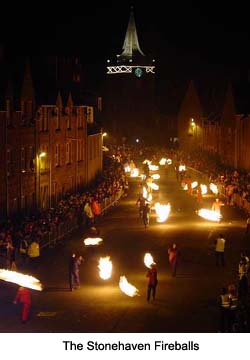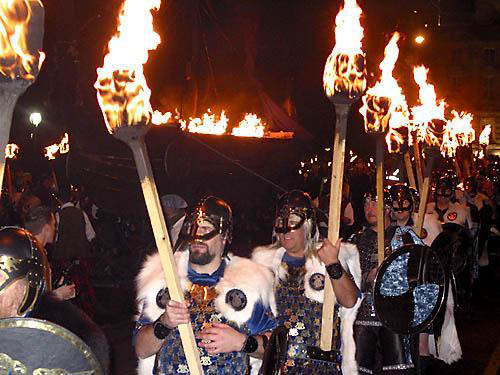Hogmanay: New Year's Eve, the Scottish Way
by Tori V. Martínez
This New Year's Eve, as revelers everywhere awkwardly mumble and
hum the mysterious verses of "Auld Lang Syne," most of them will
be completely unaware of the historic and culturally significant
celebration that not only launched the lyrically elusive song,
but also perfectly embodies it -- Hogmanay, the Scottish New
Year.
 Far from being just an unusual Scottish word for an otherwise
standard way of bringing in the New Year, Hogmanay is an amalgam
of ancient tradition and modern interpretation that offers both a
quaint glimpse into the past and an unforgettable contemporary
celebration. More notably, it has historically held a place few
other cultural New Year's celebrations can claim -- that of the
most important annual celebration in its country. So important,
in fact, that for more than 300 years, Hogmanay actually
supplanted Christmas as the winter solstice holiday in Scotland.
Far from being just an unusual Scottish word for an otherwise
standard way of bringing in the New Year, Hogmanay is an amalgam
of ancient tradition and modern interpretation that offers both a
quaint glimpse into the past and an unforgettable contemporary
celebration. More notably, it has historically held a place few
other cultural New Year's celebrations can claim -- that of the
most important annual celebration in its country. So important,
in fact, that for more than 300 years, Hogmanay actually
supplanted Christmas as the winter solstice holiday in Scotland.
The exact origins of Hogmanay in Scotland are unknown, but it was
probably introduced by invading Vikings between the 8th and 9th
centuries. It's possible the word "Hogmanay" originated from the
Scandinavian "Hoggo-nott," the word that described the feast
before the mid-winter festival of Yule, but historians and
linguists have more often attributed it to just about every other
language. Various theories tie it to Anglo-Saxon, Gaelic, Old
English, French, Old French, Norman French, Flemish, Spanish and
even Greek. Possibilities include that the word was derived from
Haleg Monath, an Anglo-Saxon term meaning "Holy Month,"
and the French phrase au gui mener, meaning
"lead to the mistletoe."
 Whatever its origins and etymology, Hogmanay has
managed to retain many of its unique traditions and still evolve
to suit modern times, despite centuries of change and upheaval in
Scotland. This exceptional fusion may have been possible in part
because both the old and new elements of Hogmanay seem to follow
the superstitious, yet optimistic, Scottish belief that a
prosperous and happy year will only occur if it begins with luck,
joy and a break with the past. Whatever its origins and etymology, Hogmanay has
managed to retain many of its unique traditions and still evolve
to suit modern times, despite centuries of change and upheaval in
Scotland. This exceptional fusion may have been possible in part
because both the old and new elements of Hogmanay seem to follow
the superstitious, yet optimistic, Scottish belief that a
prosperous and happy year will only occur if it begins with luck,
joy and a break with the past.
Accordingly, a traditional Hogmanay first involves a thorough
housecleaning or "redding," removal of the ashes from the
fireplace, and repayment of all debts -- all of which must be
done before "the bells" at midnight on December 31st. It's
questionable how many modern Scots actually follow these rather
dreary tasks as part of Hogmanay, but there's little doubt that
the purpose of each is as relevant today as it was in the past.
With a clean house -- both literally and figuratively -- the
celebrations can commence with a light heart and a clear
conscience.
Perhaps the best-known modern Hogmanay celebrations are the
all-night street parties held in cities like Edinburgh and
Glasgow, which routinely attract crowds of 100,000. But these are
a modern innovation, only introduced as recently as the 1990s.
Smaller-scale local parties, balls, and dances known as
ceilidhs all offer more traditional ways of celebrating
Hogmanay throughout Scotland. Whether large or small, most modern
Hogmanay celebrations typically feature live music, fireworks,
parades and Highland dancing.
Although most modern Hogmanay celebrations have long since
abandoned some of the more unusual traditions of long-ago -- such
as people dressing in cow hides and running through the village
while being hit with sticks -- many aspects do echo the past. The
most formal of the local parties may require men to wear
traditional Highland dress, and the New Year is invariably
ushered in by bagpipers, followed by traditional Scottish dancing
until the wee hours of the morning. And the impressive firework
displays, torchlight processions and bonfires of the modern
street parties all represent or mimic the ancient traditions of
the original Viking celebrations.
In particular, the theme of fire in modern Hogmanay celebrations
holds important historical significance and represents "burning
the old year out." Some Scottish and far-northern English towns
and villages still practice modernized forms of ancient
pre-Christian fire ceremonies designed to ward off evil spirits
and ensure a prosperous new year. Near Aberdeen, in the town of
Stonehaven, Hogmanay celebrations feature a High Street parade of
well-trained locals swinging giant fireballs -- by some accounts
weighing as much as 20 pounds -- attached to wire handles. In the
Northumberland town of Allendale, New Year's Eve is still
celebrated with a parade of individuals known as "guisers"
carrying burning tar barrels on their heads. Other variations of
Hogmanay fire ceremonies are practiced around Scotland, such as
the Flambeaux Procession in Comrie and a giant bonfire in Biggar,
with most attracting locals and visitors alike.
As curious to outsiders as these revelries may sound, once the
clock strikes midnight, Scots celebrate the coming of the New
Year in much the same way as in other English-speaking countries
-- with kisses, good wishes, celebratory noises and, of course,
the singing of "Auld Lang Syne." The traditional song is actually
a fairly modern addition to Hogmanay, although it was based on
old Scottish ballads and poems that were adapted by Scottish poet
Robert Burns. Put to music, Burns' version replaced "Good-night
and joy be with you all" in the 18th century as the traditional
Hogmanay song. Burns himself thought the phrase "Auld Lang Syne"
-- an Old Scots phrase meaning "days of long ago" or "times gone
by" -- was "exceedingly expressive." Clearly, much of the rest of
the world agreed.
 Almost as soon as "the bells" have stopped and the last verse of
"Auld Lang Syne" is sung, Hogmanay stands apart once again with
the tradition known as "first footing." Quite possibly a relic
from the time of the Vikings, the tradition dictates that the
luckiest Hogmanay revelers will receive a visit from a tall, dark
and handsome man bearing gifts. Known as "first footers" because
they are the first people to step across the threshold after the
stroke of midnight, their appearance and what they carry varies
in different parts of Scotland, but they always embody an
important part of bringing good luck to the new year. Conversely,
the wrong first footer can be considered bad luck, particularly
women, fair-haired men and people with flat feet. It's said that
the bias against blond men recalls the ancient fear of rampaging,
fair-haired Vikings.
Almost as soon as "the bells" have stopped and the last verse of
"Auld Lang Syne" is sung, Hogmanay stands apart once again with
the tradition known as "first footing." Quite possibly a relic
from the time of the Vikings, the tradition dictates that the
luckiest Hogmanay revelers will receive a visit from a tall, dark
and handsome man bearing gifts. Known as "first footers" because
they are the first people to step across the threshold after the
stroke of midnight, their appearance and what they carry varies
in different parts of Scotland, but they always embody an
important part of bringing good luck to the new year. Conversely,
the wrong first footer can be considered bad luck, particularly
women, fair-haired men and people with flat feet. It's said that
the bias against blond men recalls the ancient fear of rampaging,
fair-haired Vikings.
No matter how or where Hogmanay is celebrated in Scotland, the
festivities don't end with the close of New Year's Day, known as
"Ne'erday," but continue right through January 2nd. In fact, it's
interesting to note that both January 1st and 2nd are public
holidays in Scotland, while only January 1st is recognized in
England. The extended Scottish holiday marks the historical
importance of Hogmanay -- not Christmas -- as the traditional
time for gift-giving and mid-winter, or solstice, celebrations.
The transfer of holiday observance was due in large part to the
Church of Scotland, which in the late 17th century deemed
Christmas too "Popish," or Catholic, and discouraged its
celebration. Hogmanay's pagan roots, national popularity and
ideal timing made it the perfect alternative, and so it remained
until the mid-20th century, when Christmas began making a
comeback. Although these days Scotland appears to be fully
re-indoctrinated in the Christmas tradition, Hogmanay still
manages to rival Christmas in popularity and importance.
Even as Hogmanay continues to evolve, it's this sense of
timelessness and resilience that distinguishes it as a truly
exceptional New Year's celebration. And those who understand and
appreciate the celebration know that the "exceedingly expressive"
lyrics of "Auld Lang Syne" -- elusive as they may be -- seem like
they were meant for Hogmanay alone.
More Information:
We regret that we no longer have the resources to maintain up-to-date links and/or hours and pricing details for the various sites and attractions listed on this website. For more information about the location(s) listed above, please use your favorite search engine or visit Wikipedia.
Tori V. Martínez is a writer and freelance public
relations professional who spends as much time as possible
researching and writing on her favorite subject -- history.
Several years ago, Tori eschewed the life of a full-time career
woman to travel and live around the world, particularly in
Britain, where she spent considerable time exploring and
researching historic destinations. At the moment, she is living
in the US with her husband -- a Spaniard she met in England --
and is happily writing for a variety of online and print
publications.
Article © 2005 Tori V. Martínez
Viking photos taken by Simon Hollington, provided
courtesy of The Home of Hogmanay; Stonehaven photo courtesy of Stonehaven Fireballs Homepage
|
